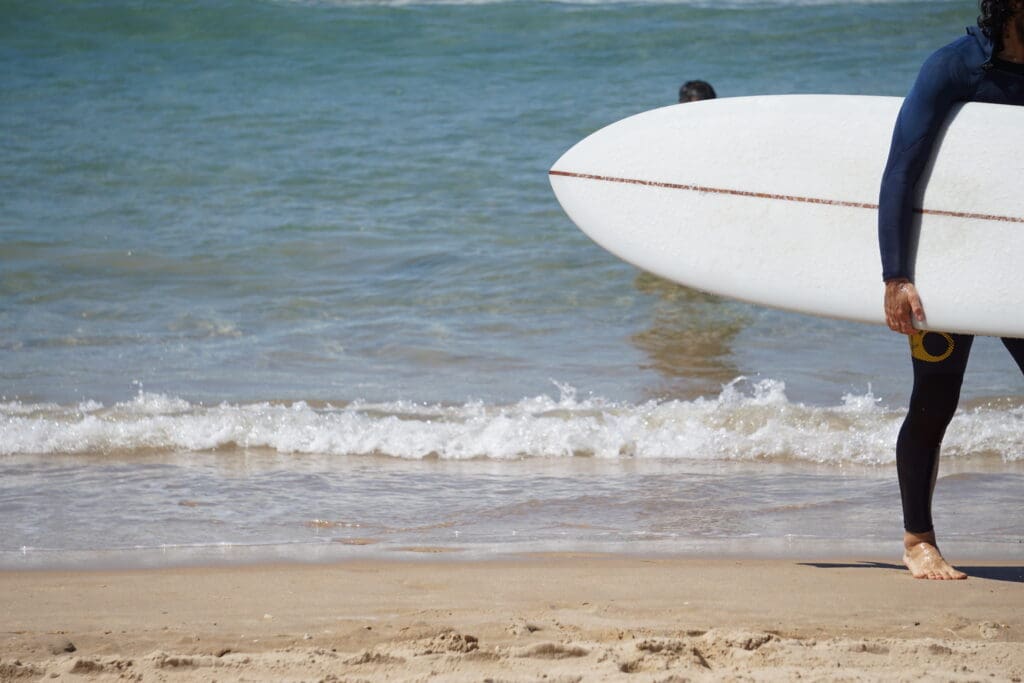Donovan
You’ve mastered the basics, can catch waves on your own, and even pull off some turns – congratulations, you’ve joined the ranks of intermediate surfers! Selecting your next surfboard can be a challenge, but don’t worry, we’re here to guide you with essential tips and common pitfalls to avoid.
Transitioning from a beginner board like a foamie or mini-malibu to something more performance-oriented is an exciting step. However, it’s crucial to choose wisely to continue your progression.

Jumping straight to a high-performance board is a common mistake. Remember, catching waves is key to improving. Opting for a board with too little volume can make wave-catching challenging and hinder your fun. A good rule of thumb is to not dip below 40 liters in volume, keeping in mind that each surfer’s ideal volume depends on their size, skill level, and the waves they surf.
Consider the type of waves you usually surf. If you’re tackling smaller, mushier waves, a bit more volume can help maintain buoyancy and momentum. On the other hand, for faster, steeper waves, you might want a board that allows more control and maneuverability, even if it means slightly less volume.

While the length of your board is important, don’t focus on it solely. Boards between 6’4” and 7’0” are typical for intermediates, but the board’s outline and shape are equally crucial. Look for a board with ample volume in the front third to ease wave entry.
When considering the size, also think about your surfing goals. Are you looking to improve your paddling and wave catching, or are you aiming to start performing more aggressive maneuvers? Your goals will influence the ideal length and shape of your board. A slightly longer board might help with paddling and stability, while a shorter board can enhance your ability to carve and turn.

A wider nose or increased volume in the front third of your board can significantly aid in catching waves. This design feature helps in easier wave entry, a vital aspect for intermediate surfers.
The width of the board can also affect your ability to maneuver. A wider board might be more stable and easier to paddle, but it can also be less responsive when turning. Finding the right balance based on your skill level and the types of waves you surf is key.

Consider boards in the evolutive, egg, or mid-length categories. Evolutive surfboards are particularly suitable as they’re designed for intermediate levels, offering a balance of maneuverability and ease of use.
Egg shapes, known for their rounded outlines, offer an excellent middle ground between the stability of a longboard and the maneuverability of a shorter board. Mid-lengths, typically ranging from 6’6 to 7’10 feet, are great for smooth, flowing turns while still being forgiving enough for those still mastering their skills.

Local shapers are invaluable during this transition. Many offer the opportunity to test their boards and can create custom shapes based on your feedback. Custom boards can be surprisingly affordable, starting around €400, and it’s a great way to support local craftsmen. Plus, intermediate-level boards have good resale value as many surfers go through this phase.
Engaging with a local shaper can also be a learning experience. They can provide valuable insights into board design and how different shapes and styles can impact your surfing. This knowledge can be instrumental in your development as a surfer.
One common pitfall is opting for a board that’s too advanced for your current skill level. While it’s tempting to go for a high-performance shortboard, if you’re not ready, it can hinder your progress. Similarly, don’t underestimate the importance of wave conditions. A board that works well in powerful, barreling waves might not be the best choice for the softer waves you usually surf.
Another mistake is overlooking the importance of a good fit. Just because a board looks great or works well for someone else doesn’t mean it’s right for you. Consider your height, weight, fitness level, and surfing style when choosing a board.
In conclusion, choosing the right intermediate surfboard is about finding a balance between challenging yourself and having fun. Consider your goals, the typical wave conditions you face, and don’t rush into a decision. Remember, the right board can significantly enhance your surfing experience and progression.
Explore the wide range of options on Borasurfar and take your surfing to the next level with the perfect intermediate surfboard!
No results available
ResetWe believe surfing should be about fun, respect, and love for the ocean.
We want to bring surfing back to its roots, emphasizing the importance of community and connection.
We envision a world where surfers spend less time online and more time in the water, where local craftsmanship and businesses are valued.